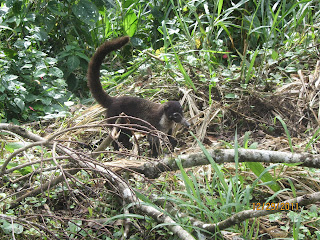Travel day, 12-29, part 4
12:11 AM
Once we hit that dirt road, travel slowed considerably. We crept along, and finally took our second scheduled rest break, at a place Erick called "El Dos"--a little town? Not sure. We parked at this restaurant...
which had two other large busses and several tour vans already there. I didn't even try for coffee, just got in the line for the men's room. (Yes! a line for the men's room.). But most of us quickly found the promised treat of this stop, an old-style sugar cane press, that we'd get to try out. Erick let us taste some of the raw cane stalk (sweet, juicy, crushing to a fiber-something mess you have to spit out). I volunteered to be the "oxen" to turn the press, and had my big Conan the Barbarian moment, though without the muscles suddenly growning in the jump-cut editing.
Pushing wasn't too hard til they redoubled the already crushed cane stalk and fed it back through. That slowed me down. But we got a pitcher of juice,
a frothy slightly green-tinged liquid, which tasted sugary, and here's a surprise, kind of green.
which met with mild enthusiasm...
Well, that was exciting, but we were offered a little sip of the real purpose of that sugar cane juice, the local moonshine that it turns into. Here's the Fresa moonshine face:
and the Cindy moonshine face (I did have to ask her to repeat it for the camera):
Our host posed with his press and his product, Steve at his side:
And then back on the bus. 12 kilometers to go. It took over another hour. We arrived well after 1 p.m. But it's always worth the stops.
bob
which had two other large busses and several tour vans already there. I didn't even try for coffee, just got in the line for the men's room. (Yes! a line for the men's room.). But most of us quickly found the promised treat of this stop, an old-style sugar cane press, that we'd get to try out. Erick let us taste some of the raw cane stalk (sweet, juicy, crushing to a fiber-something mess you have to spit out). I volunteered to be the "oxen" to turn the press, and had my big Conan the Barbarian moment, though without the muscles suddenly growning in the jump-cut editing.
Pushing wasn't too hard til they redoubled the already crushed cane stalk and fed it back through. That slowed me down. But we got a pitcher of juice,
a frothy slightly green-tinged liquid, which tasted sugary, and here's a surprise, kind of green.
which met with mild enthusiasm...
Well, that was exciting, but we were offered a little sip of the real purpose of that sugar cane juice, the local moonshine that it turns into. Here's the Fresa moonshine face:
and the Cindy moonshine face (I did have to ask her to repeat it for the camera):
Our host posed with his press and his product, Steve at his side:
And then back on the bus. 12 kilometers to go. It took over another hour. We arrived well after 1 p.m. But it's always worth the stops.
bob



















































